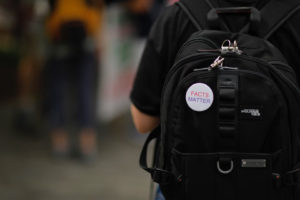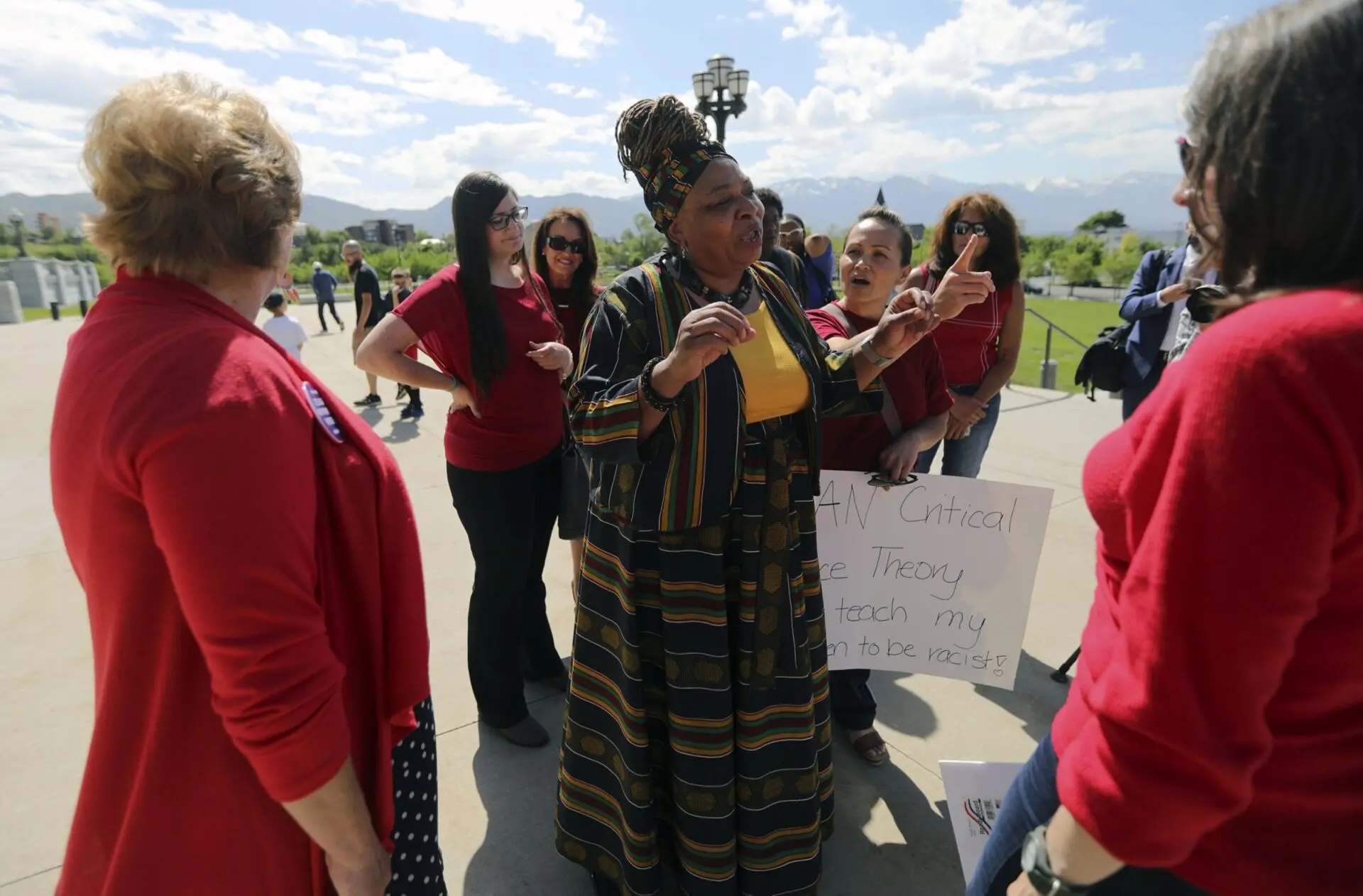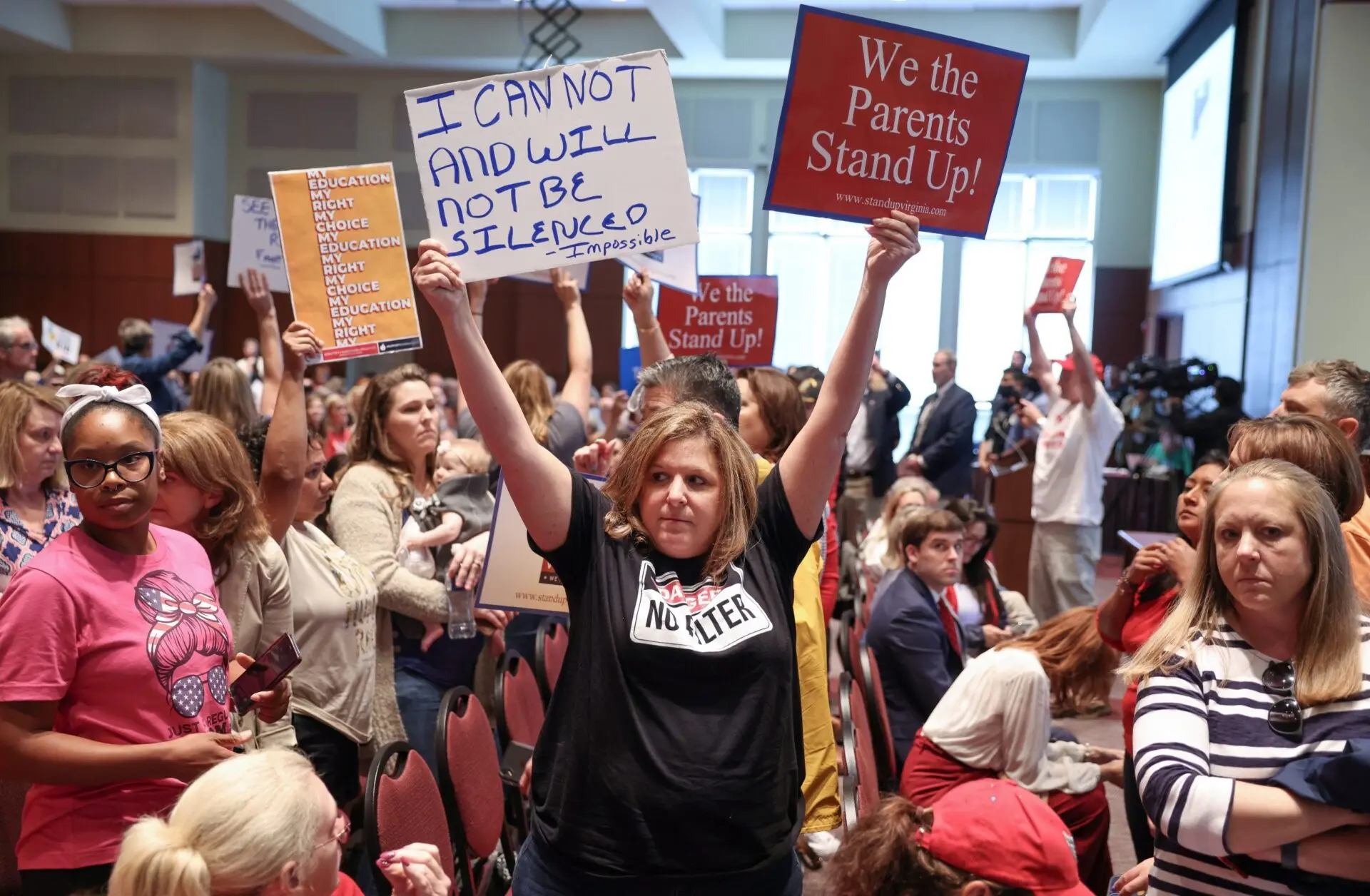Correcting Some Misinformation about Gag Order Laws
This post is part of a series from PEN America tracking the progress of educational gag orders and censorious legislative efforts against educational institutions nationwide. These bills are tracked in our Index, updated weekly.
There’s a lot of misinformation out there about educational gag orders – the legislative restrictions on the freedom to read, learn, and teach that are now law or policy in 19 states. Below, PEN America responds to five popular (but incorrect) myths about educational gag orders.
Myth #1: Since politicians and the public have always played a role in shaping public K-12 education, educational gag orders are nothing new and nothing to worry about.
Public education in America has always been political – and that’s a good thing. Parents, politicians, and the general public should care what goes on in the classroom – after all, they have a vested interest in producing thoughtful and informed adults. All teachers know this, and most welcome greater community interest in the public education system.
But what we are seeing today is different. The legislators behind these gag orders are not interested in a productive back-and-forth with educators; what they want is simply to dictate the terms of teachers’ surrender. These bills are designed to silence conversation, to render entire ways of thinking beyond the pale. Some accomplish this through sweeping bans and punishments. Others rely on language so vague and ambiguous that self-censorship, absent a clear indication otherwise, is the only safe option.
We have been here before. During the 1920s, politicians and activists launched a campaign to expel the theory of evolution from the classroom, an effort that culminated in the infamous Scopes Trial of 1925. During the Second Red Scare of the 1950s, many state governments required teachers and professors to sign loyalty oaths to the United States as a condition of employment. In both cases, the result was not an advance in knowledge, but a chilling effect that harmed educators, students, and the public alike.
Those loyalty oaths are back. Now, they are accompanied by hotlines for reporting teachers, orders to teach “positive” histories of the United States, and a range of proposals to monitor classrooms and ensure that no teacher departs from the state-approved line.
There is also a profound difference between parents and the public partnering with schools and dominating them. Many of the bills appear intent on the latter. For example, they would give parents the authority to determine what books are stocked in school libraries, excise and replace units of study, and force the removal from the school of any material that appears to “harm [their] child or impairs the parent’s firmly held beliefs, values or principles.”
Others propose to create an elaborate “opt-in” system whereby each parent must give active consent before their child is taught a specific topic. In theory, teachers could customize their lesson plans to suit the beliefs of each individual parent. In practice, most will feel compelled to create a single lesson plan for all students designed around the views of the most restrictive and puritanical parent.
This point bears repeating: these laws do not empower parents to have a greater hand in their children’s education. Instead, they pit parents against teachers and parents against other parents, ensuring that the loudest, most intolerant parent in every school district will dictate what all children in that district read and learn in the classroom.
Public education is public. Parents and the wider community have an essential role to play in the educational process by providing input on curricula or school policies. The line between “involvement” and “interference” is admittedly a fuzzy one, about which people of good faith can disagree. But there is nothing fuzzy about these bills. Wherever the line lies, they undoubtedly cross it.
Myth #2: Some blue states mandate critical race theory, so red states should be allowed to ban it.
Defenders of educational gag orders frequently cite the recent passage in California of Assembly Bill 101, which requires all public high school students to complete an ethnic studies course prior to graduation. In particular, they point to a controversial model ethnic studies curriculum developed by the state that includes lessons on Black Lives Matter, colonialism, and other topics associated with “critical race theory.”
So if a blue state like California can mandate critical race theory, why can’t a red state like North Dakota ban it?
This objection is mistaken in two ways. First, California did not mandate critical race theory. Its model curriculum is just that – a model. Individual school districts are free under the law to use or not use any part of it they see fit. If they prefer, they can develop their own ethnic studies curriculum more in line with local values or the needs of their students. It is entirely up to local authorities and the local curricular processes already in place, many of which already involve parents.
Second, there is a fundamental asymmetry between a law requiring coverage of a topic and a law prohibiting it. California’s law gives school districts wide discretion to design and deliver instruction on ethnic studies. The actual topics and philosophical approaches are purposely undefined in the legislation, and instead are left to individual schools and teachers. As a piece of legislation, it opens the door to new conversations and ways of thinking.
By contrast, North Dakota’s ban on critical race theory, which became law last November, shuts down conversation. It prohibits public school teachers from including in their curricula any suggestion that “racism is not merely the product of learned individual bias or prejudice, but that racism is systemically embedded in American society and the American legal system to facilitate racial inequality.”
This is a conversation killer. There is nothing here for schools to customize or tailor to suit their community’s values. It does not throw open any closed doors, nor facilitate any new debates. It simply legislates censorship, imposing a regime of silence where otherwise there might be speech. As we have argued elsewhere, the vagueness of bills increasingly appears to be the point: to effectuate a broad form of intimidation toward educators.
Myth #3: Educators are already banned from teaching concepts like intelligent design and creationism, so they should be banned from teaching critical race theory, too.
Contrary to what this common argument states, public schools actually don’t ban intelligent design or creationism. Teachers are free to discuss the theory that a god or gods created the universe, with the caveat that, particularly in a science class, they may not present this as fact. Teachers can even assign curricular materials that promote that theory as true. Otherwise, they would be unable to have their students read Dante Alighieri’s The Divine Comedy or Martin Luther King, Jr.’s Letter from a Birmingham Jail, both of which offer an emphatically Christian account of the cosmos. Even the Bible is fair game and is widely assigned in public schools across the country.
In other words, teachers can discuss these ideas and expose students to proponents of them. They can weave them into their teaching and even invite students to consider why so many people find them attractive.
By contrast, many educational gag orders explicitly prohibit the mere inclusion of certain ideas associated with “critical race theory.” For instance, Kentucky HB 487 prohibits schools and colleges from distributing any instructional materials that “disparage the fundamental American value of equality” or that “advocate, inculcate, or promote bigotry, revisionist history, or critical social justice.” Rhode Island H 7539 forbids schools from offering courses or stocking library books that “center” the “history, literature, current events, or cultural contributions of individual identity groups.” And Tennessee HB 580, which became law last year, bars public K-12 teachers from including in a course anything that promotes “division between, or resentment of, a race, sex, religion, creed, nonviolent political affiliation, social class, or class of people.”
In other words, these bills and laws do not merely require teachers to discuss certain ideas neutrally and without endorsement, the way a history teacher might present Greek mythology or the Biblical narrative. Rather, in many instances, they require them to avoid those ideas altogether.
Myth #4: Educational gag orders target only K-12 schools, not colleges and universities.
In fact, of the more than 185 educational gag orders introduced in state legislatures since January 2021, over a third have specifically targeted higher education. And the percentage of higher ed bills was much higher in 2022 than in 2021: 42% so far this year, versus just 26% last year. A new law in Tennessee and a bill in New Hampshire apply restrictions only to college classrooms, with no mention of K-12 schools. The Lieutenant Governor of Texas has pledged to end tenure for new university faculty and to revoke it from tenured faculty who teach critical race theory. In response to new educational gag orders, Iowa State University advised faculty to avoid syllabus language that might “draw scrutiny,” University of Florida urged faculty to avoid constitutionally protected speech that might violate a new law and cost the university money, and Oklahoma City Community College canceled an elective course on race and ethnicity.
At the university level, educational gag orders are part of a nationwide campaign to discredit public colleges, undermine tenure protections, and limit academic freedom in college classrooms. There is also some evidence that they could endanger public universities’ accreditation status, which could have dire consequences both for the quality of higher education and for students’ access to federal financial aid.
Many educational gag orders also target diversity trainings offered at colleges and state agencies, and by state contractors and nonprofit organizations. As of June 2022, over half of all educational gag orders that have become law target such trainings specifically.
Even educational gag orders limited to K-12 classrooms impact higher education. For example, teacher training programs in university education departments are limited in what they can teach their students, since those students, once graduated, must teach under gag order restrictions. Educational gag orders also restrict early college credit programs traditionally administered or designed by university personnel, such as concurrent enrollment courses taught at high schools for college credit, or courses in the Advanced Placement program, which prepare students for tests that often count for college credit when passed successfully. The impact of educational gag orders on college and university education cannot be easily separated from that on K-12 schools.
Myth #5: K-12 teachers don’t have free speech rights in the classroom, so educational gag orders don’t raise any Constitutional concerns.
As we wrote in our November 2021 report on educational gag orders, “The teaching of history, civics, and American identity has never been neutral or uncontested, and reasonable people can disagree over how and when educators should teach children about racism, sexism, and other facets of American history and society. But in a democracy, the response to these disagreements can never be to ban discussion of ideas or facts simply because they are contested or cause discomfort. As American society reckons with the persistence of racial discrimination and inequity, and the complexities of historical memory, attempts to use the power of the state to constrain discussion of these issues must be rejected.”
It is true that public K-12 school teachers’ First Amendment rights are not as robust as those of their counterparts in higher education. Outside of the classroom, the Supreme Court ruled in Pickering v. Board of Education [1968] that teachers and other public employees generally can speak freely as private citizens on matters of public concern, though not necessarily on matters relating to their employment.
There is no definitive Supreme Court decision about K-12 teachers’ free speech rights in a classroom. The most significant recent case addressing the speech of public employees, Garcetti v. Ceballos [2006], held that public employees’ speech that forms part of their official duties is not subject to First Amendment protections. The Court, however, expressly declined to address whether its analysis applies “to a case involving speech related to scholarship or teaching.” In Mayer v. Monroe County Community School [2007], the 7th Circuit Court of Appeals upheld, on employment law grounds, the termination of a public school teacher for telling her students she opposed the Iraq War. “The school system does not ‘regulate’ teachers’ speech,” the Court explained, “as much as it hires that speech.” The Supreme Court declined to hear the case, letting the ruling stand. Subsequent cases drawing upon both Pickering and Ceballos reach differing conclusions, leaving the question open.
It is also not clear that these judicial decisions guarantee teachers enough freedom in the classroom to maximize their students’ educational attainment, to respond to curiosity, or to foster an inquisitive mindset. And some free speech advocates have been critical of them. “How can students learn the skills of democracy,” writes historian Jonathan Zimmerman, “unless teachers are allowed to share their own perspectives?”
Questions remain, then, about the precise extent of teachers’ First Amendment protections. But that’s not the end of the story either. Because while teachers may not have strong First Amendment rights, students do.
In Tinker v. Des Moines [1969], the Supreme Court offered a ringing defense of students’ First Amendment expression. “It can hardly be argued,” the Court declared, “that either students or teachers shed their constitutional rights to freedom of speech or expression at the schoolhouse gate.” Subsequent decisions have narrowed this protection, but much of it still remains.
Further, in Island Trees v. Pico [1982], the Supreme Court was asked to determine whether a New York school board had violated the Constitution when it removed books deemed “anti-American” and “just plain filthy” from the school library. In his plurality decision, Justice William J. Brennan wrote that the school board had erred by violating students’ right to receive information and ideas, which he called “an inherent corollary of the rights of free speech and press that are explicitly guaranteed by the Constitution.”
Pico makes clear that school boards do have “broad discretion” in the “management of school affairs.” That discretion, however, “may not be exercised in a narrowly partisan or political matter.” Schools must be run in accordance with “the transcendent imperative of the First Amendment” and cannot “constrain the spectrum of available knowledge.” The government, then, cannot ban materials or concepts from schools in ways that are content- or viewpoint-specific – something educational gag orders arguably do. “Our Constitution,” Brennan wrote, “does not permit the official suppression of ideas.”
In addition to First Amendment concerns, as two new ACLU lawsuits and an additional lawsuit in Florida point out, educational gag orders are also open to potential challenges on Fourteenth Amendment grounds. The laws could violate the amendment’s Equal Protection Clause if they are motivated by discriminatory intent – something clearly suggested by the statements of many lawmakers who have proposed or voted for such laws. Because of their excessive vagueness, educational gag orders may also violate the amendment’s due process clause that requires laws to specify exactly what actions or statements trigger penalties.
Finally, if educational gag orders do pass constitutional muster – and again, there is ample reason to think that many do not – that does not make them good policy. Even the specter of a policy that would forbid teachers from presenting material or ideas in their classrooms that they and/or their school administrations deem relevant to student learning in their discipline chills speech, censors teachers and students, and limits students’ mastery of academic subject matter and understanding of the world around them. Restricting ideas in the classroom is bad for students, bad for teachers, and bad for our society.
This update from PEN America was compiled by Jeffrey Sachs, Jeremy C. Young, and Jonathan Friedman.
Sign Up for Updates on Educational Gag Orders
To receive further updates on educational gag orders and censorious legislative efforts against schools and higher education nationwide, sign up below.








